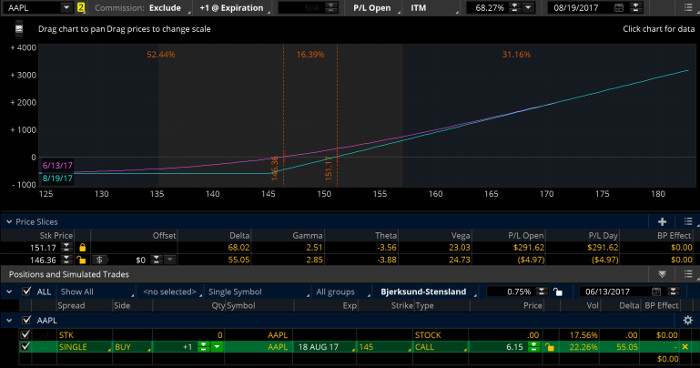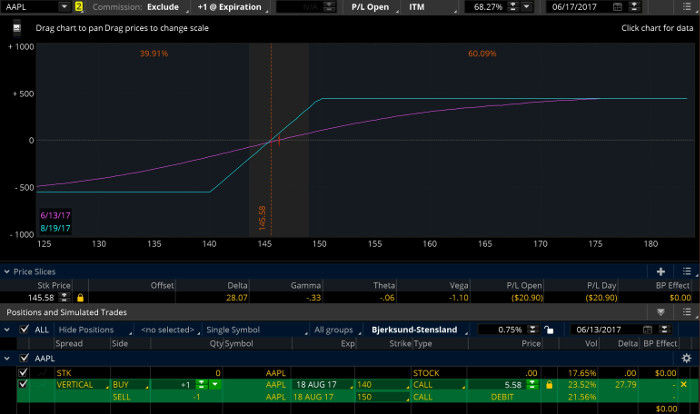Traders have an advantage over stock buyers, particularly when the markets are at or near their all-time highs. says Juan I. Sarmiento, DVM, PhD, President and Founder of PutCallGenie. He uses AAPL as an example.
In my previous article Trading Call Options, I discussed buying call options as an alternative to buying plain shares of stock. When we buy shares of stock, the probability of making a profit (more than $0.01) is 50%. When we buy a call option with a strike price that is at or near the current market price of the stock (this option is said to be “At-The-Money” or ATM), our probability of success is much less than 50%, mainly because we are paying for an additional time and volatility values which will evaporate by expiration.
Here is how to increase our probability of profit in an options trade.
Option traders usually try to neutralize the negative effects that time, decay, and volatility tend to erode the value of the option and overvalue the price of an option at entry, respectively.
The most common approach is to sell an “Out-of-The-Money” (OTM) option simultaneously with the purchase of the ATM option. Ideally, both the option being bought and the option being sold have the same expiration date, so that most of the time decay is neutralized. In addition, both options also have similar implied volatilities. In effect, we are buying and selling implied volatility, which neutralize each other and hence neutralize the effect of “Vega.” This Vega measures the increase (or decrease) in the value of an option with every point of increase or decline in its implied volatility.
Since both time value (Theta) and Vega contribute to the “extrinsic” value, which will be worth $0 at expiration, it makes sense to want to neutralize its effect as much as possible. The combination of the long and short options with the same time to expiration but different strike prices are known as “Vertical Spreads” and can be easily entered as a single order, for which we can submit a bid at a favorable price.
In order to better understand the vertical spread, let me illustrate with an example (this is not a recommendation). If I were to buy 1 ITM (“In-The-Money”) call of Apple (AAPL) with 60 days to expiration with a strike price of 145 while the stock is trading for $146.40, I would pay $615, my breakeven point would be $151.14 and my probability of profit would be 31.16% (see figure 1).

Long call with 60 days to expiration, showing low probability of profit and high break-even point.
It is noteworthy that Theta (measures the change in the price of an option with the passage of time) is negative, which means that we lose $3.88 with every day that passes (all other factors being equal).
Vega, on the other hand, is positive. This means that if volatility goes down (which it tends to do with the rise of the stock price), my option loses extrinsic value at the rate of $24.73 for every single point of decline in volatility. If we simultaneously sell 1 OTM call with a strike price of 150, our cost will be reduced to $558, but more importantly, our probability of a profit will be increased to 60.09% (figure 2). Theta is neutralized to only -$0.06 and Vega becomes negative ($-1.10). We have effectively neutralized the negative effects of holding a long option with high extrinsic value, thus increasing our probability of making a profit.

Vertical Spread with 60 days to expiration, showing high probability of profit and low break-even point.
When investors become options traders for the first time, they might have been attracted by the characteristic leverage of options calls, compared to buying stocks.
If you are anticipating a quick move in the price of a stock because of a specific set up such as a decline to support, you may be inclined to buy the stock, but that requires more capital and a tendency to hold the stock for the long term.
Buying a call requires much less capital, but it has a low probability of success because of the extrinsic value of that option. Thus, selling an OTM call effectively neutralizes Theta and Vega. Just like the long call, the vertical spread has limited risk. Before you enter the trade you can decide how much you are willing to lose, if the trade does not go your way.
Unlike the long call, however, the potential profits are limited with a vertical spread, and this can be frustrating when your stock moves up more than $5 in a very short time. This is because the short call will appreciate at first, and you will have to either wait until expiration to see the value of the short call erode, or take a fraction of the profits you were expecting. For some, that is a small price to pay for the increased probability of success.
I suggest that you could play the long call well by being picky, selecting only stocks with a very specific set up and be willing to take your profits in a timely fashion. A user of vertical spreads can afford to trade more often because probabilities are on his side, but that user must be willing to take a fraction of the expected profit. Both traders, however, would have an advantage over stock buyers, particularly when the markets are at or near their all-time highs. There are other ways to neutralize volatility and time decay without limiting profits. After all, many of us like to trade momentum stocks. I will discuss these in upcoming articles in this series.





















